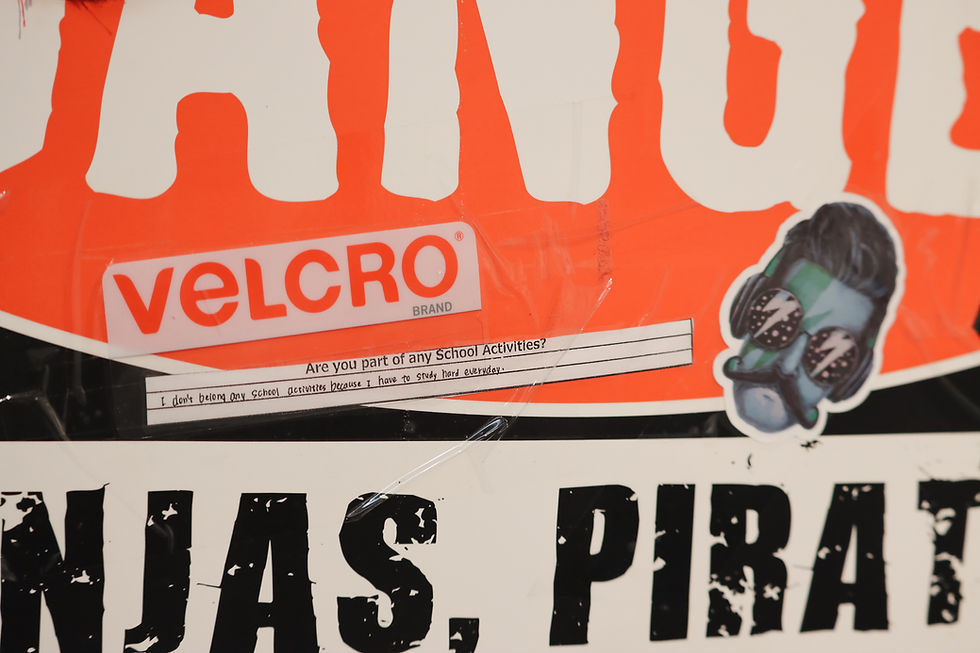

Where
are We?
Senior Thesis
Exhibition
The American landscape is transforming, a process defined by progress yet riddled with contradictions. The work in “Where Are We” is rooted in my experiences traveling across the United States from a young age, particularly along the Midwest I-35 corridor—a route I have traversed countless times by car and plane. My exploration of shifting landscapes extends beyond the U.S. to Japan, where I have encountered parallel yet contrasting changes in infrastructure and mobility. Two books have influenced the work in this show. Just a Dream (1990) by Chris Van Allsburg, a beloved childhood book of mine, illustrates overlapping highway overpasses stretching endlessly. The construction expanding I-35 into a multi-level highway in my hometown, San Antonio, has made this once dreamlike vision become my reality. My work is also in dialogue with Megan Kimble’s City Limits (2024), which documents injustices embedded in highway infrastructure projects and highlights the concept of "induced demand"—the paradox that more lanes lead to more traffic, not less. These juxtapositions raise urgent questions: How do we move forward? What are we leaving behind?
Works




View From I-35
2025
70” x 52”
Textiles, Acrylic
Purchased by the Art and Music Library, University of Rochester
View From I-35 is rooted in my experiences traveling along the Midwest I-35 corridor—a route I have traversed nearly every year since birth to visit family in Iowa, a two-three day drive. Over time, wind turbines have stretched to the horizon, mimicking flocks of birds, and oil wells mark dark spots in otherwise solid fields. A striking image is when both are right in front of the other. Driving on I-35, I see a sun setting and rising on different visions for the future of American Energy.
View From I-35 was constructed using recycled fabric from @Sewgreen Rochester, with Longarm Sewing assistance from the Aurora Sewing Center. Made possible with support from the Department of Art & Art History’s Production Grant.

Series: Texas Stack and Other Wildflowers (2025)
A directional interchange (or stack interchange, 4-6 levels), is a type of grade-separated junction between two controlled-access highways. The inclusion of access roads along all highways and the prolific number of such stacks in Texas have led 5-level interchanges to be labeled a “Texas Stack.” Like the state flower, the Bluebonnet, these interchanges are unique markers of a Texas landscape. Here, I have rendered four interchanges from San Antonio, TX, only including highways and adjacent access roads. While proportionally accurate from a birds eye view, these works remove the junctions from their environment, idealizing and beautifying the gray concrete obelisks.
A fifth level is currently under construction at the second intersection in this series.
1. San Pedro Creek, I-10, I-35
7” x 7”
Reduction Linocut on Paper
Edition of four
2. I-35 N, Loop 1604 E
7” x 7”
Reduction Linocut on Paper
Edition of three
3. Hwy 281 N, Loop 410
7” x 7”
Reduction Linocut on Paper
Edition of four
4. Hwy 281 N, Loop 1604 E
7” x 7”
Reduction Linocut on Paper
Edition of four
5. Matrix for San Pedro Creek, I-10, I-35
Linoleum
6. Matrix for I-35 N, Loop 1604 E
Linoleum
7. Matrix for Hwy 281 N, Loop 410
Linoleum
8. Matrix for Hwy 281 N, Loop 1604 E
Linoleum

Rebirth of I-35, I
2024
36” x 27”
Inkjet on Phototex
Construction is everywhere, never ending, everchanging, and squeezed into spaces it should not be. Local residents should not need navigation apps for their daily commute, but many do in San Antonio, TX. On this day, I forgot to check Google maps, and subsequently took this image while traffic ground to a halt. I was also late to work. Of all the pillars planned for the second level of I-35, this offramp pillar is fairly short.

Rebirth of I-35, II
2024
19” x 11.5”
Screen Print on Washi Paper
Here, we see a completed pillar for the second level of I-35. Located exactly on the southeast side of Toepperwein Road’s intersection with I-35. From a distance, it is as high as IKEA’s iconic triangular sign (located 4 min north of this pillar).




Series: Doors (2025)
Size Variable
Found Objects, Tape, Paint, Post-it-notes
The first thing I ever taped to a door was a “Danger” sign on my childhood bedroom. I added to it each year, until I left for college and had to leave the door behind.
Doors is a personal archive made public—an evolving series of found objects, each taped on a door and shaped by the limitations and possibilities of the space they once lived in. College dorm policies, shifting architecture, and a need for portability forced me to rethink the door not as a static canvas, but a movable one: part scrapbook, part signpost, part protest against uniformity. Each “Door” carries its own story and memory. Together, they form a curated reflection of lived places, responding to current events, questioning permanency, and documenting transformation.
Doors are made in the moment, not assembled in one go. Doors were physically attached to the spaces I resided in, and moved for exhibition.
Door 1
2007 - 2024
Door 1 was stripped from my childhood door in San Antonio. Many objects illustrate a deep middle school fascination with rocketry. In an alternate reality, I like to think I become a rocket scientist.
Door 2
2020 - 2022
Door 2 captures my early college years, shaped by the isolation of the pandemic and the swell of nationwide protests.
Door 3
2023 - 2024
Door 3 emerged during a study abroad trip in Japan, absorbing fragments of life lived across language and cultural thresholds.
Door 4
2024 - Present
Door 4 marks the most recent chapter: a leave of absence from school and full-time work.




At the Pump
2025
3.5” x 6” x 11.5”
Paper Sculpture, Blind Embossing
Edition of two
Soy Milk carton turned into a gas station pump.




Ways to Akiota
2025
Laser print on Vellum, Paper, Wood, Magnets, LED
9.5” x 11” x 2”
Purchased by the Art and Music Library, University of Rochester
In December 2024, as part of the Kakehashi Program, I visited a small town north of Hiroshima called Akiota. This quiet, rural town was a stark departure from the bustling Tokyo I'd been in just hours before. Like many rural areas in Japan, Akiota is facing a population crisis. Younger generations move to the cities and rarely return to start families of their own.
In Ways to Akiota, I transpose three modes of transportation—train, car, and pedestrian—across one another. These forms of movement, and the environments they pass through, are interdependent and can be layered in multiple ways. A black light illuminates the images, but the further back each image travels, the more obscured it becomes. The overall shape of this piece mirrors the front-facing view of a JR Line train car, the same company that once ran the Akiota station, and the one I traveled with throughout my journey. In the train window, we see reflections of what surrounds us and what has passed, as well as a hint of the interior: what we carry with us, and the future we can not yet see.
Akiota lingered in my memory, as it was one of the first towns in Japan to have its train station decommissioned. This struck me as deeply contradictory to the image I’ve always held of Japan, a country often praised for its advanced, efficient public transportation and vision for sustainable development. In contrast to the American narrative of a "car-based future," where roads and highways symbolize progress, Akiota's shift away from rail and back toward car dependency felt like a reversal. Here, the introduction of cars didn’t represent forward movement; it marked a retreat. A member of my host family, one of whom is holding the red umbrella in this work, shared stories of their daily life since the train station closed. Without access to rail, they drive twenty+ minutes through winding mountain roads for most shopping. Extended family, including their own children, can no longer visit easily (most Japanese citizens do not own cars, so this change comes with real limitations).
This work features an archived photo from Platform Journeys of the now-abandoned Akiota Station. A separate key, modeled after a Toyota car key and Omamori, controls the lights.
Massi. Image of the former Akiota Station platform. Platform Journeys, 23 Apr. 2013, http://blog.livedoor.jp/massi1-houmu/archives/52300697.html. Accessed 30 Apr. 2025. Image.















